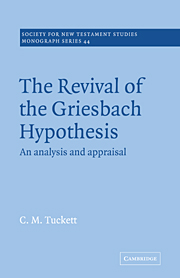Summary
In the study of the Synoptic Problem, no conclusions can have complete certainty, and any solution is theoretically possible. One can never prove with mathematical rigour that one solution is right, or that another is wrong. Nevertheless, various phenomena considered in this discussion have suggested that the GH is considerably less viable as a solution to the Synoptic Problem than the 2DH. Farmer's work on the history of the study of the Synoptic Problem has been seen to be unsatisfactory at a number of points: any extra-scientific factors allegedly at work in the minds of source critics in the past are very difficult to substantiate; moreover, Farmer's work ignores the very real criticisms which led to the rejection of the GH. Many of those criticisms are still applicable to the contemporary revival of the GH by Farmer and others.
When some of the general phenomena were considered in detail, no evidence was found to support the GH. Moreover, in some cases the evidence was found to tell strongly against the GH and in favour of the 2DH (e.g. in the use of the historic present, in some of the minor agreements, and in the discussion of the ‘overlap’ passages). The inconsistent redactional procedure (especially by Mark) which the GH has to envisage must be more adequately explained if the contemporary revival of the GH is to be taken seriously.
In the detailed examination of the wording of individual pericopae, the results frequently suggested some form of 2DH.
- Type
- Chapter
- Information
- Revival Griesbach Hypothes , pp. 186 - 187Publisher: Cambridge University PressPrint publication year: 1983

